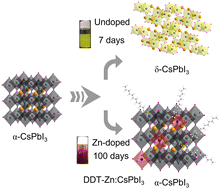Zn-derived ligand engineering towards stable and bright CsPbI3 nanocrystals for white emitting†
Abstract
Lead-halide perovskite nanocrystals (NCs), such as red-emitting CsPbI3, have gained significant attention due to their promising applications such as display backlights, light-emitting devices, and lasers. However, it is still a great challenge to stabilize CsPbI3 NCs and further tune and optimize their luminescence properties. In this study, effective Zn-derived ligand engineering was successfully conducted to create highly stable and bright CsPbI3 NCs for LEDs. The phase stability of CsPbI3 NCs at room temperature was improved by Zn ion-derived 1-dodecanethiol (DDT) ligand engineering, in which the ratios of Zn/DDT play an important role. Under optimized conditions, the as-treated CsPbI3 NCs were well dispersed and revealed uniform size distribution and a high photoluminescence (PL) quantum yield of 95.4%. In addition, the treated CsPbI3 NCs retained the initial PL efficiency after being stored at room temperature for more than 100 days. No phase change occurred for the NCs under UV light irradiation and thermal cycling conditions. Finally, these CsPbI3 NCs were used for white light-emitting diodes, which had advantages in a wide color gamut and good stability.



 Please wait while we load your content...
Please wait while we load your content...